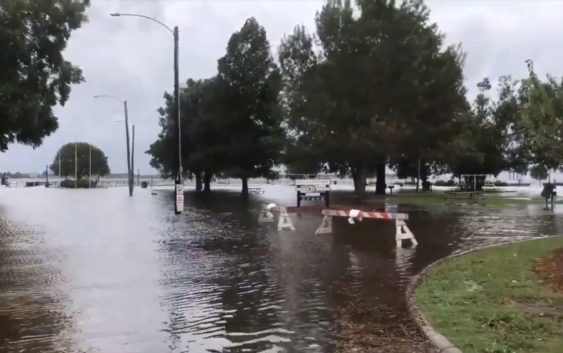- At least 4 dead, hundreds rescued after deadly floods ravage South Texas
- Today on Texas Standard: Deadly floods swamp South Texas, shatter records
- North Carolina radio station was a critical lifeline after Hurricane Helene. Then it became the voice of recovery.
- As storms approach, Rock Hill residents look back on last April's devastating hailstorm
- As storms approach, Rock Hill residents look back on last April's devastating hailstorm
Neuse River overflows, flooding New Bern as county leaders urge ‘shelter in place’

Drowning rain and Neuse River flooding inundated roads in New Bern and greater Craven County on Thursday with conditions worsening into the night as Hurricane Florence hovered off the North Carolina coast.
“We’re expecting conditions to continue to deteriorate,” said Amber Parker, the county’s human resources director, on Thursday afternoon.
Before midnight, they had. A map sent out by the City of New Bern showed just how widespread the flooding had become. The North Carolina Department of Transportation’s Ferry Division reported a 10-foot high storm surge above the normal water level at the Cherry Branch Ferry Terminal in Havelock, which is located in Craven County.
“Interactive map showing the high water areas in New Bern so far. Unfortunately this will get worse,” the city’s account tweeted around 9 p.m.
New Bern sits at the intersection of the Neuse and Trent rivers. The map showed the Trent River had overflowed as well. The Neuse flows into the Pamlico Sound, which is separated from the Atlantic by the Outer Banks.
The city said more than 15,000 customers were without power Thursday night. WCTI, New Bern’s ABC affiliate, was forced to evacuate its building Thursday night, a development it noted while giving updates on the weather.
The county issued a mandatory evacuation on Tuesday, Parker said. By Thursday evening, officials were advising people who decided to stay in Craven County to shelter in place.
Residents up and down the coast and near rivers were told to seek higher ground as rain falls and rivers rise.
The triple threat of rain, storm surge and river flooding triggered the mandatory evacuation of all residents and visitors in Pender County on Wednesday, after the National Weather Service forecast rainfall up to 40 inches, storm surge of 9 feet to 13 feet and record flooding of the Cape Fear River.
“We needed to get people off the coastline and away from the Intracoastal Waterway,” said Tammy Proctor, Pender County spokeswoman. “We felt this was the best way to act.”
The National Weather Service is forecasting record Cape Fear River flooding in Pender and Duplin counties early next week, with the water reaching about 24 feet, or 11 feet above flood stage.
River flooding can mean the threats from high water linger after storms have passed.
Wayne County still has roads to repair from Hurricane Matthew’s destruction two years ago, said county spokeswoman Carol Bowden. Flooding from Hurricane Matthew and Hurricane Floyd in 1999 essentially cut the county in half, blocking travel between north and south, she said.
The county sets up two staging areas, in the north and south, for emergency response, Bowden said. The National Weather Service is forecasting moderate flooding of the Neuse River near Goldsboro beginning Sunday. The river is expected to reach 22 feet or about four feet above flood stage.
“There’s not an aspect of this we have not prepared for,” Bowden said.
Counties say they have swift water rescue personnel ready.
Even without mandatory evacuations, counties are encouraging people who live in low-lying areas to seek shelter. In Raleigh, The N&O reported Wednesday that the city sent out notices to 26,000 people encouraging those who have experienced flooding or have had their home cut off by flooded roads before to stay with friends and families.
And most of the people currently in the Chapel Hill shelter are residents of Camelot Village condominium, a neighborhood that frequently floods, said county spokesman Todd McGee.
With the high water comes the threat of dam failures. At least 17 dams in the state burst during or after Hurricane Matthew, The News & Observer reported. Thirteen of the 17 were in the Cape Fear River Basin. Forty dams failed during Hurricane Floyd.
In a statement, the state Department of Environmental Quality said it is monitoring dams it considers the most vulnerable — those that are under a notice of deficiency or dam safety order, or are undergoing repair or construction.
More than 3,440 dams in North Carolina are registered with the U.S. Army Corps of Engineers. More than 2,770 are privately owned.
A News & Observer analysis found 24 functioning “high hazard’ dams in 18 counties at or near the coast. A dam’s federal hazard rating is a measurement of its risk potential, or what would happen if the dam failed.
High-hazard dams that fail would probably cause loss of life.
State records show that all of the high-hazard dams in the 18 counties are in either unsatisfactory or poor condition.
Bonner: 919-829-4821; @Lynn_Bonner